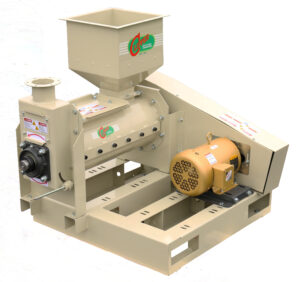Description
Many seeds have appendages (awns, pappi, hairs, wings, plumes) or are encased in pods that are adaptive for seed dispersal in nature. Hairy and “fluffy” appendages often cause seeds to cling together once harvested. Debearders (deawners) are used to remove appendages from seed that are difficult to clean with air-screen separators. The debearder consists of a rotating shaft inside a steel cylinder. Steel beaters projecting from the shaft move the seed mass through the cylinder. Stationary posts on the steel cylinder prevent the seed mass from rotating with the horizontal shaft and provide vigorous rubbing action between the moving and stationary posts, other seed, and appendages. The rotation speed of the shaft and distance between the beaters can be adjusted to limit seed damage. A weighted discharge gate controls the amount of time the seeds remain in the cylinder. A debeader is very versatile machine that has been used successfully on many types of seed. Its cleaning action is less aggressive than that of a hammermill. The debearder should not be used to clean fragile seeds as seed damage can occur. Always consult seed manuals or experts to determine appropriate use of the debearder.
Application
Debearding and dehulling improve flowability of seeds through further seed cleaning operations to remove remaining debris, increase purity, and reduce the bulk of the seed lot. Analysis of seed lots that have been debearded requires less time, and some seed lots would be nearly impossible to analyze without debearding. The seeds also flow better through seeding equipment, thereby reducing clogging and improving seeding rate uniformity. Seed-to-soil contact is improved, potentially improving the potential for successful germination and emergence. Debearding of some species can reduce dormancy and improve water uptake.
References / Additional Information
Desai, B.B.; Kotecha, P.M.; Salunkhe, D.K. 1997. Seeds handbook: Biology, production, processing, and storage. New York, NY: Marcel Dekker, Inc. 640 p.
The Food and Agriculture Organization of the United Nations and Africa Seeds. 2018. SEEDS TOOLKIT Module 2: Seed processing: principles, equipment and practice. Rome: The Food and Agriculture Organization of the United Nations and Africa Seeds. 79 p.
Harmond, J.E.; Brandenberg, N.R.; Klein, L.M. 1968. Mechanical seed cleaning and handling. USDA Agricultural Handbook No. 354. Washington, DC: U.S. Department of Agriculture, Forest Service. 38 p.
Jorgensen, K.R.; Stevens, R. 2004. Chapter 24. Seed collection, cleaning, and storage. In: Monsen, S.B.; Stevens, R.; Shaw, N.L., comps. Restoring western ranges and wildlands, vol. 3. Gen. Tech. Rep. RMRS-GTR-136-vol-3. Fort Collins, CO: U.S. Department of Agriculture, Forest Service, Rocky Mountain Research Station: 699-716.
Vaughan, C.E.; Gregg, B.R.; Delouche, J.C. 1968. Seed processing and handling. State College, MI: Mississippi State University, Seed Technology Laboratory. 149 p.
Young, J.A.; Young, C.G. 1986. Collecting, processing, and germinating seeds of wildland plants. 3rd ed. Portland, OR: Timber Press. 236 p.


